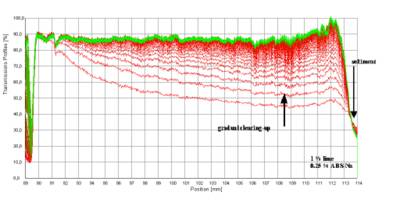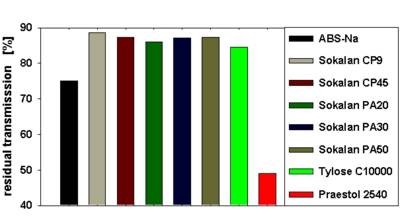Scope
Effective dispersion of lime is required in laundry applications as well as in papermaking, paints and other filed. To this end efficient stabilizers and their right concentration has to be selected.
A multisample technique based on analytical centrifugation is described which allows for an accelerated study of dispersion stability without dilution, thus avoiding changes of dispersion properties.
The efficiency of this approach is demonstrated by evaluation of the optimum dispersant concentration and by screening of a range of potential lime dispersants.
Measurement principle
The LumiFuge measures the intensity of the transmitted light over the full sample length simultaneously as function of time. (Measurement scheme see Fig. 1)

Fig. 1 Lumifuge - Measurement scheme
The data are displayed as function of the radial position, as distance from the centre of the rotation (transmission profiles, see Fig. 2).
At the same time up to 8 different samples can be analysed simultaneously.
By means of the available analysis modes ‘Integral Transmission’ (Clarification) and ‘Front Tracking’ the separation behaviour of the individual samples can be compared and analysed in detail.
Experimental/Results
1 % m/m aqueous lime dispersions were prepared with varying concentrations of sodium alkylbenzene sulfonate (ABS-Na) or with the addition of different dispersing agents. The separation stability was analysed at 1000 rpm (128 x g).

Fig. 2 Evolution of transmission profiles with time - first recorded profile undermost, last profile uppermost, centrifugation of a lime dispersion stabilized by a commercial anionic surfactant, 1000 rpm (128 x g)
The set of transmission profiles obtained for the dispersion stabilized by an alkylbenzene sulfonate is representative for the sedimentation of a very polydisperse suspension. As an easy measure of stability the transmission after 45 minutes of centrifugation was chosen. To this end the transmission values were averaged over the sample length between the radial position 101 and 103 mm using the analysis mode ‘Integral Transmission’. The higher the transmission the lower the stability. This way the stabilization effect can directly be visualized (Fig. 3 and 4).
Fig. 3 displays the dependence of dispersion stability on concentration of the anionic dispersant. Values depicted were obtained during one run of the instrument.
Fig. 4 shows a direct comparison of the performance of different dispersants. The acryl amide acrylate copolymer is the far most efficient dispersant resulting in the highest residual turbidity (lowest transmission).
From this figure the advantage of comparing multiple samples during one measurement under identical conditions becomes evident.

Fig. 3 Stabilization of lime dispersions by an anionic dispersant - effect of dispersant concentration, high transmission after 45 min of centrifugation means low stability.

Fig. 4 Direct comparison of performance of different dispersants in lime stabilization (0.1 m/m %) - high transmission after 45 min of centrifugation means low stability.


No comments:
Post a Comment